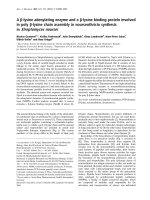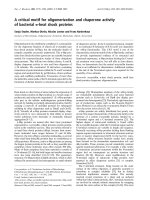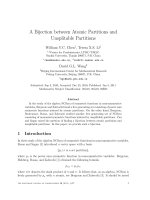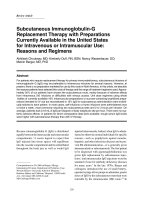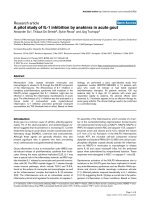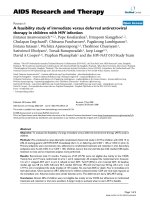Báo cáo y học: "A disparity between physician attitudes and practice regarding hyperglycemia in pediatric intensive care units in the United States: a survey on actual practice habits" pptx
Bạn đang xem bản rút gọn của tài liệu. Xem và tải ngay bản đầy đủ của tài liệu tại đây (361.4 KB, 8 trang )
RESEARC H Open Access
A disparity between physician attitudes and
practice regarding hyperglycemia in pediatric
intensive care units in the United States: a
survey on actual practice habits
Catherine M Preissig
1,2*
, Mark R Rigby
2
Abstract
Introduction: Hyperglycemia is common in critically ill patients and is associated with increased morbidity and
mortality. Strict glycemic control improves outcomes in some adult populations and may have similar effects in
children. While glycemic control has become standard care in adults, little is known regarding hyperglycemia
management strategies used by pediatric critical care practitioners. We sought to assess both the beliefs and
practice habits regarding glycemic control in pediatric intensive car e units (ICUs) in the United States (US).
Methods: We surveyed 30 US pediatric ICUs from January to May 2009. Surveys were conducted by phone
between the investigators and participating centers and consisted of a 22-point questionnaire devised to assess
physician perceptions and center-specific management strategies regarding glycemic control.
Results: ICUs included a cross section of centers throughout the US. Fourteen out of 30 centers believe all critically
ill hyperglycemic adults should be treate d, while 3/30 believe all critically ill children should be treated. Twenty-nine
of 30 believe some subsets of adults with hyperglycemia should be treated, while 20/30 believe some subsets of
children should receive glycemic control. A total of 70%, 73%, 80%, 27%, and 40% of centers believe hyperglycemia
adversely affects outcomes in cardiac, trauma, traumatic brain injury, general medical, and general surgical pediatric
patients, respectively. However, only six centers use a standard, uniform approach to treat hyperglycemia at their
institution. Sixty percent of centers believe hypoglycemia is more dangerous than hyperglycemia. Seventy percent
listed fear of management-induced hypoglycemia as a barrier to glycemic control at their center.
Conclusions: Considerable disparity exists between physician beliefs and actual practice habits regarding glyce mic
control among pediatric practitioners, wi th few centers reporting the use of any consistent standard approach to
screening and management. Physicians wishing to practice glycemic control in their critically ill pediatric patients
may want to consider adopting center-wide uniform approaches to improve safety and efficacy of treatment.
Introduction
Hyperglycemia in critically ill patients occurs frequently,
is associated with increased morbidity and mortality,
and studies in adults suggest that tight glycemic control
with insulin may improve outcomes [1-14]. Questions
regarding safety and efficacy of this therapy, extent of
outcome improvement, goal blood glucose (BG) range,
and target patient population for treatment are of signif-
icant debate [15-18]. However, despite these unresolved
issues several medical advisory committees recommend
glycemic control as standard care in adults [19-22].
Studies regarding hyperglyce mia and glycemic control
in pediatrics are limited. Those available demonstrate
that high BG is prevalent and independently a ssociated
with increased morbidity and mortality [5-14]. To date,
a single randomized controlled trial to assess whether
glycemic control improves outcomes in pediatric critical
illness has been published. In this study, although tight
* Correspondence:
1
Medical Center of Central Georgia, Department of Pediatrics, Division of
Pediatric Critical Care Medicine, 777 Hemlock Street, Macon, Georgia, 31201,
USA
Preissig and Rigby Critical Care 2010, 14:R11
/>© 2010 Preissig et al.; licensee BioMed Central Ltd. This is an o pen a ccess article distributed under the terms of the Creative Commons
Attribution License (http://creati vecommons.org/licenses /by/2.0), which permi ts unrestricted use, distribution, and reproduction in
any medium, provided the original work is properly cited.
glycemic control reduced morbidity and mortality,
approximately 25% of patients receiving this manage-
ment developed severe hypoglycemia [23]. Despite
strong data favoring treatment and official recommenda-
tions to practice glycemic control in critically ill adults,
there are no definitive studies or guidelines to help steer
the practice in pediatric critical care.
Recent studies indicate that hyperglycemia is a signifi-
cant concern among physicians caring for critically ill
children and suggest that glycemic management is routi-
nely performed [ 24,25]. Our group developed and pub-
lished a protocol to identify and manage hyperglycemia
in critically ill children and adopted this practice as rou-
tine care in our pediatric intensive care unit (ICU)
[11,13]. From current literature, however, it is difficult
to discern the breadth and extent of actual glycemic
control efforts adopted by other pediatric cent ers. To
better determine how physician attitu des towards glyce-
mic c ontrol translate to actual practice we conducted a
survey to assess the beliefs and practice habits regarding
glycemic control in a cross s ection of pediatric ICUs in
the United States.
Materials and methods
We conducted a survey to ascertain glycemic control
beliefs and practice habits at different pediatric critical
care centers in the United States. Participating centers
were chosen in an effort to include institutions of vary-
ing size, geographic location, acuity, practice model
(open versus closed unit, private versus public), and type
(medical, surgical, c ardiac, mixed). Our pediatric ICU
was not included in this survey. Request for participa-
tion was sent electronically to attending physicians
(either Division Chiefs or other faculty) at different cen-
ters between January and May 2009. Surveys were con-
ducted primarily by phone call between the investigators
and participating attending physicians. Three centers
chose to complete the survey electronically instead of by
phone for convenience. One physician was chosen as
the spokesperson to represent their institution. All parti-
cipating individuals had the opportunity to review the
survey with their coworkers and colleagues to ensure
that their respons es were representative of t heir center’s
beliefs and practices.
The survey comprised a 22-point questionnaire. Ques-
tions were developed to investigate the actual practice
habi ts of inten sivists regarding glycemi c control in non-
diabetic hyperglycemic critically ill children. Sections
within the survey included questions specific to pediatric
ICU demographic and descriptive data, individual p er-
ceptions and beliefs regarding glycemic control in criti-
cally ill children, individual and center-specific threshold
for treatment, method of treatment (if applicable), and
safety and efficacy of management at each center.
Statistical analysis was c onducted using a software
package (SPSS for Windows, version 13.0.1, Chicago, IL,
USA). We determined the significance of differences in
responses between pediatric ICU centers with c
2
analy-
sis (for categoric variables) and independent Student t-
test (for continuous variables). A P value < 0.05 was
considered statistically significant.
Results
Of 40 centers queried, 30 pediatric ICUs agreed to parti-
cipate in our survey, equat ing to a response rate of 75%.
Ten centers either did n ot respond to our electronic
request for participation or were not able to respond in
a timely manner. All participating centers responded to
all items on the questionnaire. Table 1 details demo-
graphic data and descriptions of the 30 participating
pediatric ICUs. Centers included ICUs of varying size
(based on number of beds), admissions per year, model
(urban, suburban, rural), geographic region, number of
ICU physicians, and type (medical, surgical, cardiac,
mixed, open versus closed unit) (Table 1). Most of the
centers (27/30) were affiliate d with pe diatric residency
programs, and 67% (20/30) were affiliated with pediatric
critical care fellowship programs. Almost all (29/30) par-
ticipating sites were university-affiliated.
Table 2 describes pediatric center-specific beliefs
regarding hyperglycemia and glycemic control in criti-
cally ill patients. Fourteen (47%) pediatric centers believe
that all critically ill adults with hyperglycemia should
undergo some form of glycemic control, whereas only
3/30 (10%) stated that all critically ill children with
hyperglycemia should be treated (P < 0.05). Almost all
centers (29/30, 97%) believe that at least some subsets of
adults with hyperglycemia should be routinely treated,
while 20/30 (67%) stated that at least some subsets of
children with hyperglycemia should routinely receive
glycemic control (Table 2). There was a non-uniform
respon se when sites were question ed whether hypergly-
cemia contributed to poor outcome in select subsets of
pediatric patients. While most believe that hyperglyce-
mia adversely affects outco mes in cardiac (70%), trauma
(73%), and traumatic brain injury (80%) patients, signifi-
cantly fewer thought that there was an effect on out-
comes in general medical (27%) and surgical (40%)
patients (P < 0.05).
To determine if there was a difference in attitude or
practice habits based on ICU size, we analyzed
responses based on ICU capacity. Significantly more
(83%, 5/6) small ICUs (<12 beds) stated that subsets of
critically ill children with hyperglycemia should be trea-
ted compared to large ICUs (>30 beds), in which only
55% (6/11) believed so (P < 0.05).
In contrast to other reports, our survey assessed
actual glycemic control practice habits in pediatric ICUs
Preissig and Rigby Critical Care 2010, 14:R11
/>Page 2 of 8
in the United States. Despite most centers reporting that
they believe hyperglycemia worsens outcomes in many
of their patients, and that at least some subsets of pedia-
tric patients may benefit from glycemic control, only
two (7%) centers reported that their facility uses a stan-
dard approach to screen for and treat hyperglycemia. In
addition, four other centers (13%) reported that they do
have a standard approach to manage hyperglycemia
despite no regular approach for screening (Table 3). The
vast majority of centers surveyed (80%) do not have a
regular or agreed upon approach t o glycemic contr ol.
Small centers (<12 beds) were more likely to have a
standard protocol for hyperglycemic treatment com-
pared to moderate (12 to 30 beds) and large (>30 beds)
ICUs, 33%, 15%, and 18%, respectively. For centers that
do employ a st andard treatment approach, all (6/6) indi-
cated they may use insulin infusions for glycemic
control, while some also attempt to manage hyperglyce-
mia using intermittent insulin (subcutaneous or intrave-
nous) and/or modification of dextrose in fluids. Three
of six centers that use a standard approach to treatment
employ a written insulin infusion protocol.
While few centers reported the use o f any standard
protocol for hyperglycemia management, we also
assessed the use of glycemic control based on physician
discretion a t each center. When asked what percentage
of hyperglycemic patients receive any treatment, either
via a standard protocol used by all physicians or based
on individual physician discretion, most centers (20/30,
67%) reported that likely o nly a minority (that is, 1 to
25%) of hyperglycemic patients receive any glycemic
control. Figure 1 shows estimated numbers of physicians
at each center that always, sometimes, or never treat cri-
tically ill children with hypergl ycemia. Overall, no center
reported that all of their physicians either always or
never p ractice glycemic control. Approximately 35% of
centers reported that most of their physicians always
practice glycemic control, while 7% reported that most
of their physicians n ever practice glycemic control.
When broken down by ICU size, a proportionately
higher number of small ICUs (<12 beds) were more
likely to report that all or most of their physicians prac-
tice some type of glycemic control all or most of the
time, and were more likely to report that few or none of
their physicians never practice glycemic control (P <
0.05) (Figure 1). Half of the centers stated t hat for some
of their physicians, the decision to treat hyperglycemia
depended upon diagnosis, illness severity, and duration
and severity of hyperglycemia. While most centers did
not specify any agreed upon c enter-wide exclusions for
glycemic management, three centers reported that they
exclude infants and/or patients weighing <5 kg. Taken
together, this data strongly indicate a large variation
between glycemic control practices between pediatric
ICUs, individual practitioners i n any parti cular pediatric
ICU, and at times even in the practice of any given
physician.
At present there is no consensus in critical care
(adults or pediatrics) regarding the definition of hyper-
glycemia in critical illness. Figure 2 demonstrates that
there is a wide variety of definitions of hyperglycemia
employed at different pediatric centers. The BG above
which pediatric critical care intensivists considered
patients to be hyperglycem ic ranged from 6 to 11
mmol/L (110 to 200 mg/dL), with most centers (>50%)
defining a BG cut-off between 7.7 to 8.8 mmol/L (140
to 160 mg/dL). Large (>30 beds) ICUs were more likely
to report a BG cut-off >9.9 mm ol/L (180 mg/dL) (Fig-
ure 2). For physicians that do treat hyperglycemia, BG
target ranges varied anywhere from a lower glucose
limit of 3.8 mmol/L (70 mg/dL) to a maximum goal of
Table 1 Description of participating pediatric ICUs
Number of ICUs (% of Total)
Total Number of ICUs Surveyed 30
ICU Model
Urban 19 (63)
Suburban 6 (20)
Rural 5 (17)
Type of ICU
Medical 3 (10)
Surgical 0 (0)
Cardiac 1 (3)
Mixed Medical/Surgical 10 (33)
Mixed Medical/Surgical/Cardiac 16 (54)
Open ICU 8 (27)
Closed ICU 22 (73)
Utilizes Pediatric ICU Fellows 20 (66)
Utilizes Pediatric Residents 27 (90)
Number of ICU Beds
<12 6 (20)
12 to 30 13 (43)
>30 11 (37)
Number of Critical Care Physicians
≤ 6 9 (30)
7 to 12 12 (40)
>12 9 (30)
Admissions Per Year
<1,000 8 (26)
1,000 to 2,000 11 (37)
>2,000 11 (37)
Region
Northeast 9 (30)
Southeast 10 (33)
West 3 (10)
Central 8 (27)
Preissig and Rigby Critical Care 2010, 14:R11
/>Page 3 of 8
8.8mmol/L(200mg/dL).Agoalrangeof4.4to7.7
mmol/L (80 to 140 mg/dL) was the most consistent sin-
gle target range reported (18/30 centers).
Centers were also asked what BG level they consid-
ered to be too low in critically ill children. The most
common gluc ose level (47% centers) to define hypogly-
cemia was <2.2 mmol/L (40 mg/dL), followed by 37% of
the centers using a BG <3.3 mmol/L (60 mg/dL), 10%
using a BG of <4.4 mmol/L (80 mg/dL) and 3% using a
cutoff of 2.8 mmol/L (50 mg/dL) or 5.5 mmol/L (100
mg/dL). Most centers (60%) believe that, in general,
hypoglycemia is more dangerous than hyperglycemia.
Although many centers have considered adopting a reg-
ular approach to glycemic management, 70% listed fear
of management-induced hypoglycemia as a barrier to
this practice in their unit.
Discussion
For over three years our group has practiced glycemic
control in our pediatric ICU as standard care. We routi-
nely screen patients for hypergl ycemia and implement a
center-developed algorithm to maintai n BG 4.4 to 7.7
mmol/L ( 80 to 140 mg/dL). We have previously defined
the incidence and risk factors for hyperglycemia, and
have demonstrated what appears to be an effective and
safe approach to hyperglycemic management [11,13].
Despite recent debate regarding outcome improvements
in adults and goal target glycemic ranges, numerous
Table 2 Pediatric ICU beliefs regarding glycemic control
All ICUs
N=30
(% of
Total)
Small
ICUs*
N=6
(% of
Total)
Medium
ICUs†
N=13
(% of Total)
Large
ICUs±
N=11
(% of
Total)
Believe the following patients should be treated for hyperglycemia
All critically ill adults 14 (47) 5 (83) 5 (38) 4 (36)
Subsets of critically ill adults 29 (97) 6 (100) 12 (92) 11 (100)
All critically ill children 3 (10) 2 (33) 0 (0) 1 (9)
Subsets of critically ill children 20 (67) 5 (83) 9 (69) 6 (55)
Center’s most unified belief regarding hyperglycemia in critically ill children
(allowed to choose one)
Most hyperglycemic children should be treated with insulin as this may improve outcome 3 (10) 0 (0) 2 (15) 1 (9)
Some subsets of children should be treated with insulin as this may improve outcome 20 (67) 4 (67) 8 (62) 9 (82)
Children may benefit from glycemic control, but until further studies are available this practice
should be avoided
6 (20) 2 (33) 3 (23) 1 (9)
Children may benefit from glycemic control, but the risks outweigh the benefits 0 (0) 0 (0) 0 (0) 0 (0)
* <12 beds; † 12-30 beds; ± >30 beds
Table 3 Pediatric ICU approach to hyperglycemia screening and management
Survey question All ICUs
N=30
(% of Total)
Small ICUs*
N=6
(% of Total)
Medium ICUs†
N=13
(% of Total)
Large ICUs±
N=11
(% of Total)
Centers that have a standard approach to screen for and treat hyperglycemia 2 (7) 0 (0) 0 (0) 2 (18)
Centers that have a standard approach to hyperglycemia treatment only 6 (20) 2 (33) 2 (15) 2 (18)
Centers that have neither a standard approach to screening or treatment 24 (80) 4 (67) 11 (85) 9 (82)
Management for centers that do have a standard approach to treating hyperglycemia
Insulin infusion 6 2 2 2
Intermittent insulin (IV push or subcutaneous) 1 1 0 0
Manipulation of dextrose in IV fluids 1 0 1 0
Estimate of hyperglycemic patients that receive glycemic management at your center is
>90% 20 1 0
51 to 90% 40 1 3
26 to 50% 41 1 3
1 to 25% 20 5 10 5
No one in our group practices glycemic control on any patient 0 0 0 0
* <12 beds; † 12-30 beds; ± >30 beds
Preissig and Rigby Critical Care 2010, 14:R11
/>Page 4 of 8
Figure 1 Pediatric intensivist actual glycemic control practice habits. Centers were queried regarding what percentage of practitioners
always practice glycemic control, sometimes practice glycemic control, or never practice glycemic in all, most, some, few, and none of their
hyperglycemic patients. Small ICU = <12 beds, Medium ICU = 12 to 30 beds, Large ICU = >30 beds. ICU = intensive care unit.
Figure 2 Level of blood g lucose to define hyperglycemia in different IC Us. Center s were queried regarding their definitio n of
hyperglycemia. Small ICU = <12 beds, Medium ICU = 12 to 30 beds, Large ICU = >30 beds. ICU = intensive care unit.
Preissig and Rigby Critical Care 2010, 14:R11
/>Page 5 of 8
medical advisory groups recommend routine glycemic
control as standard care in a dult ICUs [19-22]. Because
previous studies suggest most pediatric intensivists
believe hyperglycemia may be hazardous to their
patients, readers may infer that as in adult ICUs, glyce-
mic control measures are the norm in pediatric ICU
practice [24,25]. To ascertain the true practice patterns
regarding glycemic control in critically ill children, we
asse ssed beliefs and actual practice habits in a spectrum
of pediatric ICUs in the United States.
Our survey suggests a considerable disparity b etween
physician beliefs and actual practice habits among pedia-
tric ICU p ractitioners, and is the first study to assess
whether physician beliefs translate to practice strategies
in pediatric ICUs in the Unit ed States. We find that
beliefs and practice habits vary greatly between different
centers, and even among practitioners from the same
center. Recently a study from the United Kingdom also
reported a wide variation of beliefs regarding glycemic
control when respondents were queried about potential
clinical scenarios [25].
The vast majority of adult ICUs have adopted regular
approaches for glycemic control, and although the opti-
mal goal BG target is unclear, there is little debate that
glycemic control should be part of regular practice.
Even following recent reports questioning outcome
improvements and goal glycemic targets in adults, the
American Diabetes Association, American College of
Endocrinologist, and Institutes for Healthcare Improve-
ments have all published recommendations that routine
glycemic control be adopted in ICU-hospitalized adult
patients [19-22]. It is of interest therefore that many of
the respondents in our survey do not believe that all cri-
tically ill adults with hyperglycemia should undergo
management, particularly as most pediatric ICUs do at
times care for adult patients 18 to 21 years old.
Our study illuminates a dichotomy between pediatric
ICU practitioner belief s and practice. Although many
pediatric intensivists believe hyperglycemia may worsen
outcome and at least some subsets of patients may ben-
efit from glycemic cont rol, a significant minority of cen-
ters have implemented a routin e approach to identify or
treat hyperglycemia, as only 7% of centers reported a
regular approach for hyperglycemia screening and
management.
Admittedly there is little direct data indicating that
glycemic control improves outcomes in cr itically ill chil-
dren, yet a significant proportion of pediatric intensivists
have apparently individually decided to incorporate gly-
cemic c ontrol into practice while aw aiting more defini-
tive evidence. This has l ed to a wide variation in
practice not only between centers, but frequently within
the same practice group. This result rais es concern on
several levels. Al though the p articular glycemic metric
for outcome improvement in adults with h yperglycemia
is not clear, many reports suggest that in order to
achieve clinical benefi t, glycemic control must be main-
tained consistently throughout the ICU course [8,26,27].
During an ICU stay , one patient may be cared for by
many providers, and if different triggers, therapeutic
means, and targets for glycemic control of different pro-
viders are applied t o a particular patient, any potential
cli nical ben efit of glycemic control many be negated. In
addition, disparate practice habits among members of
the same physician group may lead to staff confusion
and affect the success o f glycemic management. Many
cent ers that have been successful at instituting glycemic
control measures find there is an important learning
curve, and only with the proper education and experi-
ence can glycemic control measures be implemented
effectively and safely [1-4,11,13]. Reducing practice
variability and implementing methods to improve stan-
dardization of care have been important means to
improve the quality of medical care delivered, reduce
medical errors, and improve patient outcomes across
the spectrum of medical disciplines. As such, even in
the absence of direct evidence of improved outcomes
with glycemic control in pediatric critical care, there
maybegoodreasonforpediatricgroupsinterestedin
providing glycemic control to their patients to consider
developing consistent, agreed-upon approaches to glyce-
mic management in their ICUs.
This study also highlights some notable differences
regarding hyperglycemia beliefs and practice strategies
and ICU size. We found that smaller pediatric ICUs,
that is, those with fewer ICU beds, annual admissions,
and number of attending physicians, were more likely to
treat hyperglycemia than larger institutions. Small ICUs
rarely reported that no or few intensivists treat hypergly-
cemia, and many reported that most physicians do
employ glycemic control most of the time. Proportio-
nately, smaller ICUs were more likely to have adopted a
standard approach to hyperglycemia management as
well. Further, smaller ICUs believe glycemic control
should be instituted at a lower BG threshold compared
to larger ICUs, and were more likely to report a lower
BG definition for hypoglycemia. Previous studies have
not reviewed or mentioned similar discrepancies, but
thesedifferencesmaylikelybeduetothelesschallen-
ging nature of devising and agreeing upon practice poli-
cies in smaller groups compared to those with many
practitioners.
Similar to findings by others, we report that most
pediatric ICU practitioners (60%) believe that hypoglyce-
miaismoredangerousthanhyperglycemia in critically
ill children [24,25]. Although there are reports of
immediate and long-term sequela from hypoglycemic
episodes in children, the direct relationship of the
Preissig and Rigby Critical Care 2010, 14:R11
/>Page 6 of 8
severity and duration of hypoglycemia to adverse effects
is unclear. The relatively recent influx of data showing
high incidence, severity and correlation, and perhaps
causal relationship of hyperglycemia with adverse effects
in critical illness may begin to challenge practitioners’
concepts of whether hypo or hyperglycemia is more det-
rimental. We found that 70% of centers reported that
fear of iatrogenic hypoglycemia is a major, if not the pri-
mary, barrier to instituting routine glycemic control in
their pediatric ICU. Indeed, studies in adult ICUs
regarding glycemic control report hypoglycemic (BG
<2.2 mmol/L, 40 mg/dL) rates as high as 40% in patients
receiving tight control with insulin [3,26,27]. In addition,
25% of patients participating in the recent pediatric ran-
domized controlled t rial conducted in Belgium suffered
from BG <2.2 mmol/L (40 mg/dL) [23]. These high pro-
file reports likely will further contribute to fear and
refractoriness of glycemic control in pediatric critical
care. Yet there are numerous reports of adult centers
that have implemented glycemic control measures with-
out high incidence of hypoglycemia. Our own studies
indicate that glycemic control can be implemented in
pediatric medical/surgical and cardiac ICUs with little to
no increase in hypoglycemic episodes [11,13]. T herefore
elevated rates of iatrogenic hypoglycemia do not always
necessarily follow the implementation of glycemic con-
trol protocols. Groups considering implementing glyce-
mic control should realize that physician and staff
education, training, and dedication may allow for the
effective adoption of safe approaches to glycemic
control.
Limitations of our study should be noted. While we
attempted to target centers of varying size, geographic
location, acuity, practice model, and type, data obta ined
from this survey only represents a portion of pediatric
critical care centers nationally. Howe ver, as t here are
approximately 340 pediatric critical care centers in the
United States, our survey of 30 centers does represent
approximately 9 to 10% of all centers, and thus we
believe does include a respectable sample size of pedia-
tric institutions [28]. In addition, we only surveyed one
individual from each pediatric center, as we were unable
to include every physician at e very institution in our
evaluation. However, ea ch individual chose n to repre-
sent their group for this study had the opportunity to
discuss our survey questions with other members of
their group to ensure responses adequately reflected
those of their center.
Lastly,itisnotablethatresultsfromatleasttwo
important studies in this field were published during the
time this survey was conducted, specifically the afore-
mentioned pediatric glycemic control trial by Vlasselaers
et al, and more recently the results from the NICE-
SUGAR investigators [15,23]. These studies potentially
may have influenced current practice habits in partici-
pating centers. Findings from these studies add to the
debate and controversy regarding strict versus conven-
tional glycemic control, outcome improveme nts, and
goal target BG levels in adult and pediatric populations.
It is important to recognize that results from our survey
represen t a snap-shot of current trends in pediatric gly-
cemic control, and that in this ever-evolving field, beliefs
and practices will likely continue to change as more data
becomes available to guide evidence-based practice.
Conclusions
In summary, we find that there exists a significant
awareness of h yperglycemia in pediatric ICU practice,
but that few have modified their group practice to
reflect their current beliefs. In general, pediatric intensi-
vistsmaybenefitfromrevisiting and staying abreast of
the current state of literature regarding both hyper and
hypoglycemia in critically ill children, and we recom-
mend that all pediatric practitioners should consider
treating hyperglycemia in their older, adult patients,
such as those >18 years old, as suggested by multiple
medical advisory groups. It may be premature to recom-
mend the widespread adoption of glycemic control mea-
sures in all critically ill children on the basis of outcome
studies, but for those centers that do practice glycemic
control, there may be other quality and safety reasons to
develop a center-consist ent approach to this manage-
ment. Support and encouragement of future studies to
develop and validate safe and effective pedia tric-specific
approaches to glycemic control, and to assess whether
this management impacts outcomes in critically ill chil-
dren will be of utmost importance.
Key messages
• Hyperglycemia is common in critically ill p atients,
is associated with increased morbidity and mortality,
and strict glycemic control with insulin may improve
outcomes in some populations.
• Most adult institutions have adopted regular
approaches for glycemic control, and although the
optimal goal BG target is unclear, many medical
advisory committees recommend that at least some
degree of glycemic control should be part of regular
practice.
• There is a paucity of direct evidence for glycemic
control in children; however, the only randomized
glycemic control trial conducted in critically ill chil-
dren to date does suggest outcome improvement
with this therapy in this population.
• While most pediatric practitioners do believe
hyperglycemia worsens outcomes in many of their
patients, very few centers use a standard approach to
treat hyperglycemia, and most that do attempt
Preissig and Rigby Critical Care 2010, 14:R11
/>Page 7 of 8
glycemic control use inconsistent, non-validated
approaches.
• Recommendations for routine glyc emic control in
all pediatric ICU patients may be premature at this
time, but pe diatric centers wishing to practice glyce-
mic control in their patients based on the most
recent literature and studies suggesting potential
outcome improvement may b enefit from adopting a
routine, cent er-consistent approach at their institu-
tion to optimize effectiveness and safety of this
therapy.
Abbreviations
BG: blood glucose; ICU: intensive care unit.
Author details
1
Medical Center of Central Georgia, Department of Pediatrics, Division of
Pediatric Critical Care Medicine, 777 Hemlock Street, Macon, Georgia, 31201,
USA.
2
Emory University School of Medicine, Children’s Healthcare of Atlanta
at Egleston, Department of Pediatrics, Division of Pediatric Critical Care, 1405
Clifton Rd, Atlanta, Georgia, 30322, USA.
Authors’ contributions
Both authors of this manuscript contributed significantly and equally to this
study, including study design, survey development, conduction of surveys,
data gathering and analysis, and formal writing of this manuscript. All
authors read and approved the final manuscript.
Competing interests
The authors declare that they have no competing interests.
Received: 12 October 2009 Revised: 11 December 2009
Accepted: 3 February 2010 Published: 3 February 2010
References
1. Finney SJ, Zekveld C, Elia A, Evans TW: Glucose control and mortality in
critically ill patients. JAMA 2003, 290:2041-2047.
2. Berghe van den G, Wilmer A, Hermans G, Meersseman W, Wouters PJ,
Milants I, Van Wijngaerden E, Bobbaers H, Bouillon R: Intensive insulin
therapy in the medical ICU. N Engl J Med 2006, 354:449-461.
3. Berghe van den G, Wouters P, Weekers F, Verwaest C, Bruyninckx F,
Schetz M, Vlasselaers D, Ferdinande P, Lauwers P, Bouillon R: Intensive
insulin therapy in the critically ill patients. N Engl J Med 2001,
345:1359-1367.
4. Krinsley JS: Effect of an intensive glucose management protocol on the
mortality of critically ill adult patients. Mayo Clinic Proceedings 2004,
79:992-1000.
5. Faustino EV, Apkon M: Persistent hyperglycemia in critically ill children. J
Pediatr 2005, 146:30-34.
6. Cochran A, Scaife ER, Hansen KW, Downey EC: Hyperglycemia and
outcomes from pediatric traumatic brain injury. J Trauma 2003,
55:1035-1038.
7. Srinivasan V, Spinella PC, Drott HR, Roth CL, Helfaer MA, Nadkarni V:
Association of timing, duration, and intensity of hyperglycemia with
intensive care unit mortality in critically ill children. Pediatr Crit Care Med
2004, 5 :329-336.
8. Wintergerst KA, Buckingham B, Gandrud L, Wong BJ, Kache S, Wilson DM:
Association of hypoglycemia, hyperglycemia, and glucose variability
with morbidity and death in the pediatric intensive care unit. Pediatrics
2006, 118:173-179.
9. Branco R, Garcia R, Piva J, Casartelli C, Seibel V, Tasker R: Glucose level and
risk of mortality in pediatric septic shock. Pediatr Crit Care Med 2005,
6:470-472.
10. Yung M, Wilkins B, Norton L, Slater F: Glucose control, organ failure, and
mortality in pediatric intensive care. Pediatr Crit Care Med 2008, 9:147-152.
11. Preissig CM, Hansen I, Roerig P-L, Rigby MR: A protocolized approach to
identify and manage hyperglycemia in a pediatric critical care unit.
Pediatr Crit Care Med 2008, 9:581-588.
12. Klein G, Hojsak J, Schmeidler J, Rapaport R: Hyperglycemia and outcome
in the pediatric intensive care unit. J Pediatr 2008, 153:379-384.
13. Preissig CM, Rigby MR: Pediatric critical illness hyperglycemia: risk factors
associated with development and severity of hyperglycemia in critically
ill children. J Pediatr 2009, 155:734-739.
14. Hays SP, Smith EO, Sunehag AL: Hyperglycemia is a risk factor for early
death and morbidity in extremely low birth-weight infants. Pediatrics
2006, 118:1811-1818.
15. NICE-SUGAR Study Investigators, Finfer S, Chittock DR, Su SY, Blair D,
Foster D, Dhingra V, Bellomo R, Cook D, Dodek P, Henderson WR,
Hébert PC, Heritier S, Heyland DK, McArthur C, McDonald E, Mitchell I,
Myburgh JA, Norton R, Potter J, Robinson BG, Ronco JJ: Intensive versus
conventional glucose control in critically ill patients.
N Engl J Med 2009,
360:1283-1297.
16. Griesdale DE, de Souza RJ, van Dam RM, Heyland DK, Cook DJ, Malhotra A,
Dhaliwal R, Henderson WR, Chittock DR, Finfer S, Talmor D: Intensive
insulin therapy and mortality among critically ill patients: a meta-
analysis including NICE-SUGAR study data. CMAJ 2009, 180:821-827.
17. Brunkhorst FM, Engel C, Bloos F, Meier-Hellmann A, Ragaller M, Weiler N,
Moerer O, Gruendling M, Oppert M, Grond S, Olthoff D, Jaschinski U,
John S, Rossaint R, Welte T, Schaefer M, Kern P, Kuhnt E, Kiehntopf M,
Hartog C, Natanson C, Loeffler M, Reinhart K, German Competence Network
Sepsis (SepNet): Intensive insulin therapy and pentastarch resuscitation
in severe sepsis. N Engl J Med 2008, 358:125-139.
18. Weiner R, Weiner D, Larson R: Benefits and risks of tight glucose control
in critically ill adults. A meta:analysis. JAMA 2008, 300:933-944.
19. ACE/ADA Task Force on Inpatient Diabetes: American College of
Endocrinology and American Diabetes Association consensus statement
on inpatient diabetes and glycemic control. Endocr Pract 2009, 15:1-12.
20. American Diabetes Association: Standards of medical care in diabetes
[published correction appears in Diabetes Care 28:990]. Diabetes Care
2005, 28:S4-S36.
21. Surviving Sepsis Campaign Consortium Statement. Crit Care Med 2004,
32:281-283.
22. Institute for Healthcare Improvement: Maintain Adequate Glycemic
Control. />IndividualChanges/MaintainAdequateGlycemicControl.htm, accessed Oct
2009.
23. Vlasselaers D, Milants I, Desmet L, Wouters PJ, Vanhorebeek I, Heuvel van
den I, Mesotten D, Casaer MP, Meyfroidt G, Ingels C, Muller J, Van
Cromphaut S, Schetz M, Berghe Van den G: Intensive insulin therapy for
patients in paediatric intensive care: a prospective, randomised
controlled study. Lancet 2009, 373:547-556.
24. Hirshberg E, Lacroix J, Sward K, Wilson D, Morris AH: Blood glucose control
in critically ill adults and children: a survey on stated practice. Chest
2008, 133:1328-1335.
25. Nayek P, Lang H, Parslow R, Davies P, Morris K: Hyperglycemia and insulin
therapy in the critically ill child. Pediatr Crit Care Med 2009, 10:303-305.
26. Hirshberg E, Larsen G, Van Duker H: Alterations in glucose homeostasis in
the pediatric intensive care unit: Hyperglycemia and glucose variability
are associated with increased mortality and morbidity. Pediatr Crit Care
Med 2008, 9:361-366.
27. Inzucchi SE: Clinical practice. Management of hyperglycemia in the
hospital setting. N Engl J Med 2006, 355:1903-1911.
28. Odetola FO, Clark SJ, Freed GL, Bratton SL, Davis M: A national survey of
pediatric critical care resources in the United States. Pediatrics 2005, 115:
e382-e386.
doi:10.1186/cc8865
Cite this article as: Preissig and Rigby: A disparity between physician
attitudes and practice regarding hyperglycemia in pediatric intensive
care units in the United States: a survey on actual practice habits.
Critical Care 2010 14:R11.
Preissig and Rigby Critical Care 2010, 14:R11
/>Page 8 of 8
